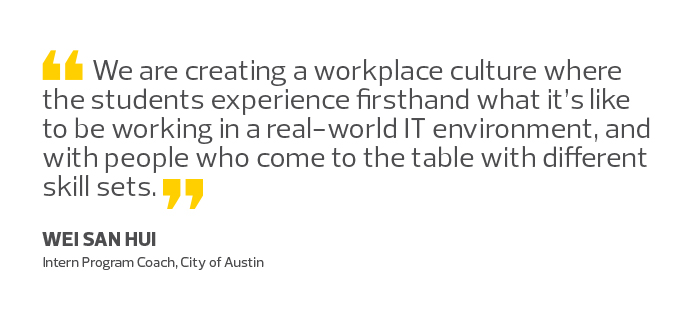State and Local IT Teams Prepare for the ‘Silver Tsunami’ with New Recruiting Tactics
More than 10 percent of the IT staff for the city of Austin, Texas, is eligible to retire this year, and if that isn’t bad enough, it’s never been more difficult — or taken longer — to find a permanent replacement for a vacant position.
“There’s just so much local competition for IT staff,” Austin CIO Stephen Elkins says.
Elkins manages a staff of 322 full-time IT specialists, and “every day, it seems, there’s an announcement that some tech company is moving into the Austin area. Even the nontech companies are hiring IT people. So, it just made us realize that we can’t continue to recruit the way we’ve always recruited. We needed to start doing things differently.”
As baby boomers continue to retire from government service and look to millennials to fill the gap, state and local IT departments everywhere need to become more innovative if they’re going to effectively recruit and retain IT talent and compete with the private sector, says Meredith Ward, senior policy analyst for the National Association of State Chief Information Officers (NASCIO).
The so-called silver tsunami alone is not responsible. The incoming generation isn’t naturally attracted to the security of a good government job, Ward says. “Years ago, someone might come in after college and stay for 30 years, but that’s not happening anymore. Now, someone might stay for three to five years and be ready to try something new. It’s a culture change, and state and local governments need to adjust and get creative about finding talent.”
Government IT Teams Get Flexible
In Austin, no idea is off the table. Elkins and his team devised multiple strategies, not only to improve their ability to recruit and retain full-time employees but also to get the IT workload done as cost-effectively and optimally as possible.
“Our city departments rely more and more on technology for their service delivery,” Elkins says. “As the work increases, we don’t get an increase in staff, so even if we were fully staffed, the work we are expected to do would outpace the bandwidth available.”
That has led the IT department to move to what Elkins calls his “flexible sourcing program,” which extends the IT workload to also include a mix of external staff sources.
IT relies on managed services and cloud providers whenever and wherever it makes sense. A managed services firm provides help desk support for Microsoft Access and SharePoint applications. Flexible sourcing also allows the department to be more proactive about determining when and how temporary and contracted staff may be leveraged.
In the past, like many IT departments, Austin would immediately place a temp or contractor into a recently vacated, difficult-to-fill position. But flexible sourcing means “we accept that a certain percentage of workforce will always be made up of those types of workers,” Elkins says. “We can really look at all of the IT skills and resources available, internally and externally, and then use them optimally based on our gaps and our needs.”
The department can place a temp or contractor into an easier-to-fill position, and then train the more senior employee into a more difficult-to-fill position or one that addresses a higher value business need.

“I don’t want us to have the mindset that when somebody leaves, we backfill for that same skill,” he says. “Instead, let’s look at the gaps in our organization and how we can be responsive to best fill the business gaps using all of the skills and resources we have available.”
Elkins isn’t only focused on staffing solutions. He’s also doing his part to increase the overall supply of IT workers. Since 2015, the department has offered an innovative summer internship program that allows participating high school students to learn about technology and come up with solutions to civic challenges. While such outreach does not provide immediate help to solve the city’s workforce needs, he expects it to boost awareness among the next generation about government’s role and their potential impact when they choose to enter public service.
“A lot of students tend to think government uses mainframes and we’re five years behind the private sector technologically, when in fact we offer them a chance to make a real difference to people they know in their community,” he says.
Bold Thinking Makes Agency IT the Next Big Thing
In the state of Washington, the challenge is more urgent: Nearly half of the staff within Washington Technology Solutions (WaTech) intend to leave within the next three years. Local companies include tech giants such as Microsoft, Amazon and Valve, so competition for top tech talent increases exponentially for local government. That reality led Deputy Director Michael DeAngelo to figure out exactly how to entice tech-savvy millennials to consider lower-paying government work. His research included figuring out exactly how his organization might differentiate its pitch to resonate with millennials and Generation Z. It also led WaTech to completely rethink staff recruitment and operations.

“Only bold thinking will work,” DeAngelo says. WaTech now relies on several new initiatives to boost its appeal, including an organizational governance model called self-management, or “holacracy,” which organizes work instead of people, allowing employees to contribute in multiple roles depending on their skills, interests and organizational need. In a pilot, the approach increased employee empowerment as well as the speed with which teams resolved issues.
Another maxim WaTech upholds: “Hire for culture,” which promotes choosing candidates based not only on their IT skills but also on how well they reflect the organization’s eight core values. The impact on recruiting has been remarkable, DeAngelo says: “When people get exposed to who we are and what we do, every single one of them says that we are their top choice.” What’s more, those candidates are willing to accept an annual pay difference of roughly $15,000 to $20,000 to work for WaTech compared with one of the top neighborhood firms. “With better targeted job classifications and ads, we have been able to get our salaries within that range and better compete locally,” he says.
Washington will also implement a new IT professional/technical classification and compensation structure, to effectively benchmark state IT salaries against industry standards.
Targeted Job Descriptions Draw in Top IT Talent
In Virginia Beach, Va., the IT department created its own IT workforce team to close an otherwise-growing skills gap. The IT department budgeted for 184 employees, but it now struggles to fill about 15 percent of open positions, says Susan Salafranca, IT workforce coordinator, who joined the team a year ago and now oversees a workforce technician and two human resources/payroll account clerks.
“We’re dedicated solely to this department, so my team can work directly with our hiring managers and give them that focus, move things along quicker in our hiring and recruiting,” she says.
Salafranca and her staff rewrote job titles and descriptions in a creative way that makes them stand out in the department’s expanded advertising efforts. And they have more time to closely monitor those sites and keep in touch with candidates. She provides weekly updates to Virginia Beach CIO Peter Wallace, and is already seeing results.
“We’re reducing vacancies from what was, on average, 12 weeks down to eight weeks,” Salafranca says. “That’s a huge difference.”
Looking for specifics? Check out these four tips on how to recruit the next generation workforce to local IT.








